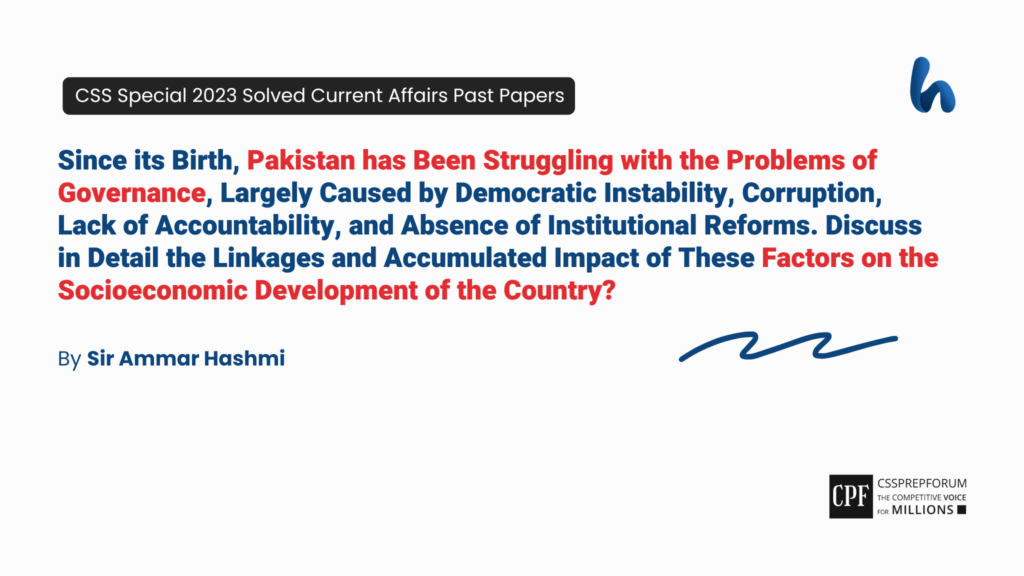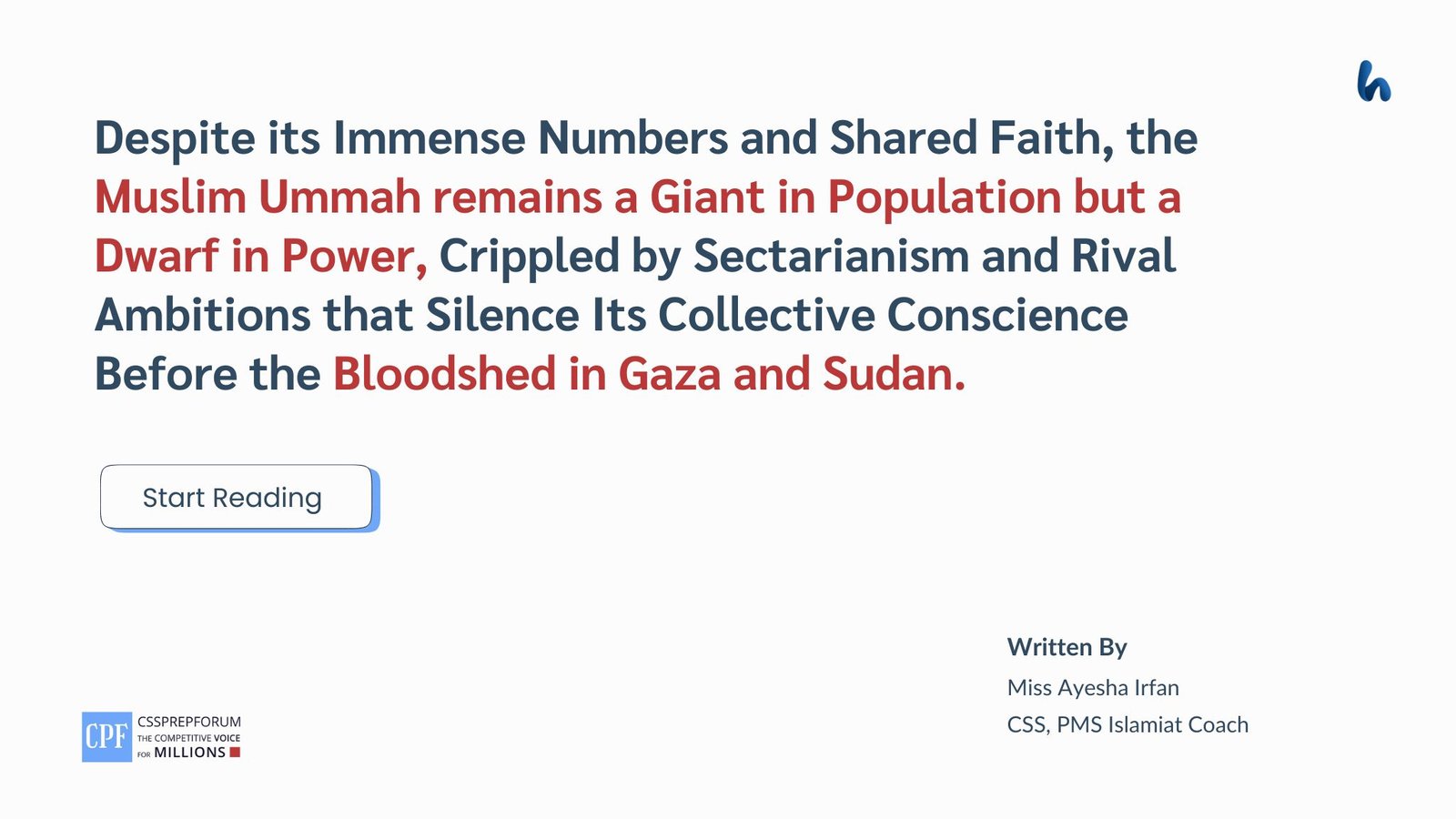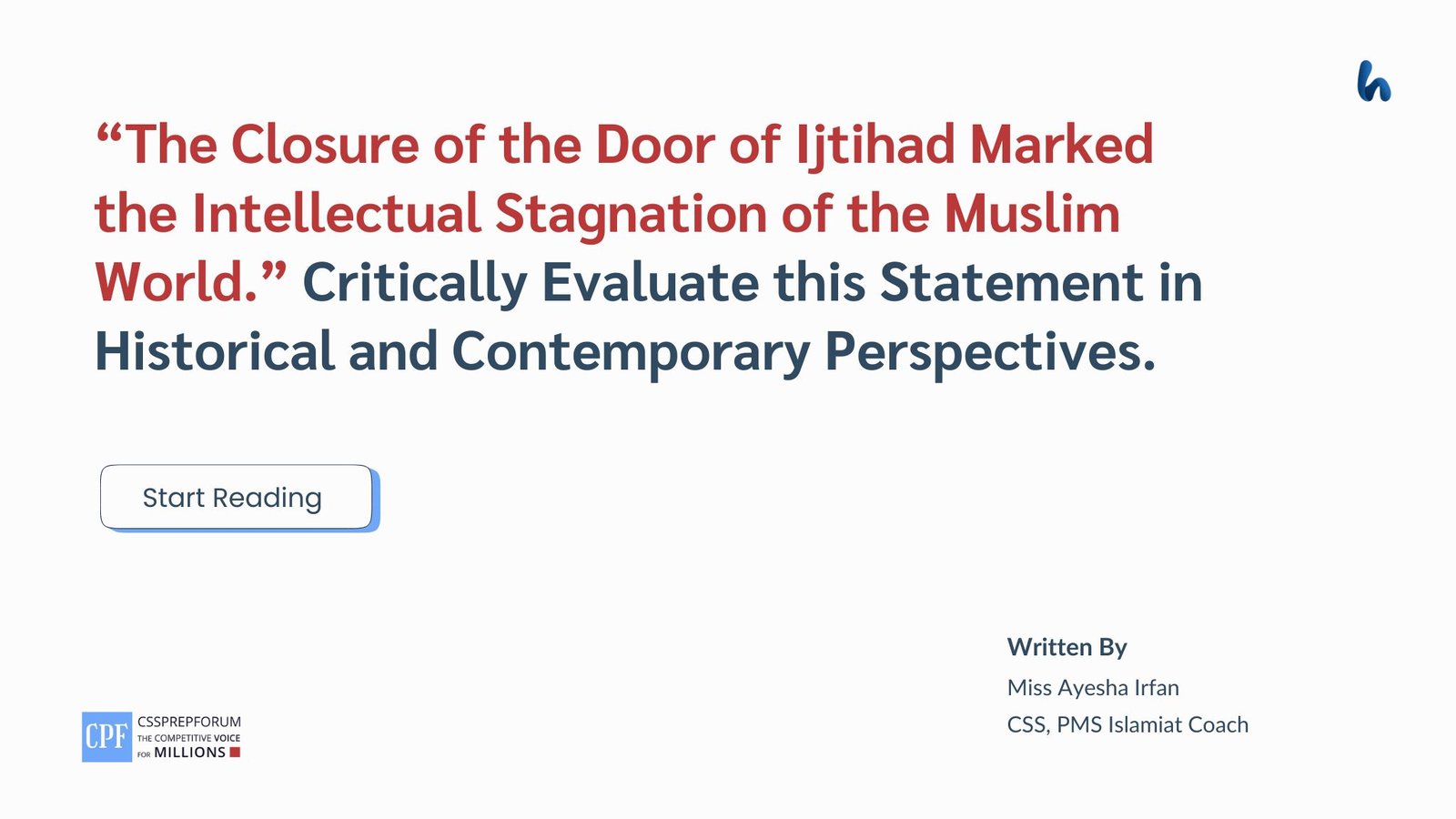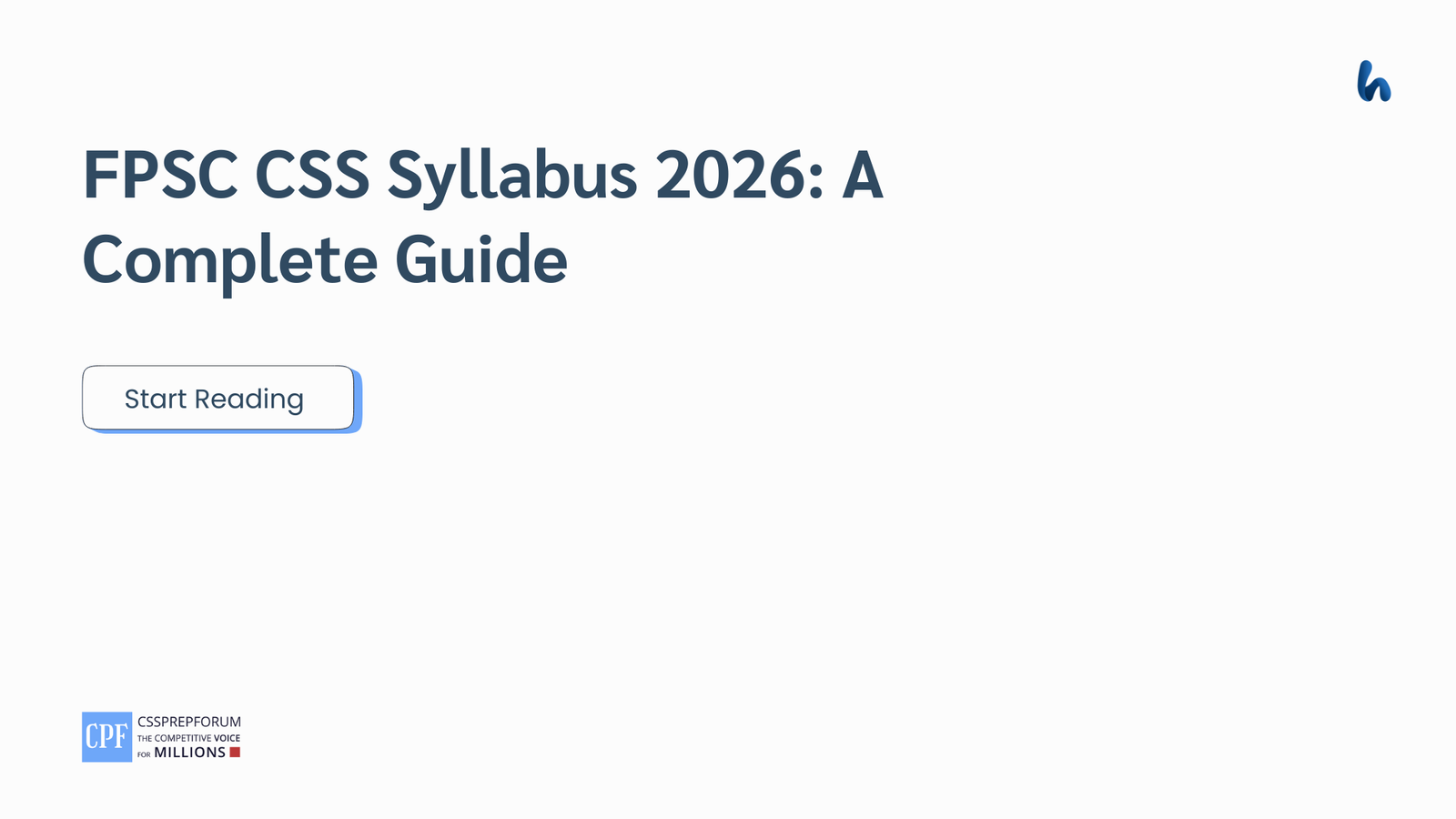CSS Special 2023 Solved Current Affairs Past Papers | Governance Crisis and the Socio-economic Development of Pakistan
The following question of CSS Special Current Affairs 2023 is solved by Sir Ammar Hashmi, the best Current Affairs Coach, on the guided pattern of Sir Syed Kazim Ali, which he taught to his students, scoring the highest marks in compulsory subjects for years. This solved past paper question is uploaded to help aspirants understand how to crack a topic or question, how to write relevantly, what coherence is, and how to include and connect ideas, opinions, and suggestions to score the maximum.

Outline
1-Introduction
2-Problems of governance in Pakistan since its inception
3-Linkages and impacts of problems on the socio-economic development of the country
- ✓Socio-economic characteristics in geography
- ✓Analyzing geo-strategic impact
- ✓A role of politics in Pakistan’s development
- ✓Long-standing structural weaknesses pose risks
- ✓Impact of inadequate accountability impact
- ✓Institutional reforms and Pakistan’s economic performance
- ✓Political dynasties and economic development
4-Suggestions to set high-quality governance in Pakistan
- ✓Authenticity has to build
- ✓Securing human rights
- ✓Law and order have to impose
- ✓Legal executive activism
- ✓Decentralization has to be setup
- ✓Straightforwardness has to be conveyed in every institution
5-Conclusion

Answer to the Question
Introduction
Pakistan has had serious administration problems ever since attaining independence in 1947. Three main categories may be used to categorize the causes of weak governance: structural, which includes social structures, historical context, and geopolitical position; power dynamics and allocation; and the present situation in Pakistan. This also covers institutional changes, political unpredictability, corruption, and a lack of accountability. The nation has had leadership transitions and military takeovers, which have resulted in unequal governance and policies. With scandals and a low score on Transparency International’s Corruption Perceptions Index, corruption has been a persistent issue. Insufficient accountability has resulted in ineffectiveness and a drop in public trust. Reform efforts are hampered by vested interests, political resistance, and organizations’ usage of antiquated models. The socioeconomic progress of Pakistan is impeded by these governance issues. It is clear from the World Bank study that political unrest and corruption negatively impact economic expansion.
Problems of Governance in Pakistan since its inception
Governance has been a problem in Pakistan since its inception on the world map. A complex web of problems that includes major democratic instability, corruption, lack of accountability, and institutional reforms and the following mentioned are the one that hinders progress and development of the country
Pakistan’s geography presents challenges in administering certain regions, such as Baluchistan, the Federally Tribal Areas, and the vast desert regions in Southern Punjab, eastern Sindh, and parts of Baluchistan. These areas face significant obstacles in communication, transportation, goods and services delivery, administration, and security. Despite extracting resource riches from these areas, the state has historically been less able to provide basic amenities. These areas are the most protested and marginalized in Pakistan, and their power is contested.
Pakistan’s militarization have been significantly influenced by its tense ties with Afghanistan and India, shaped by issues such as the 1947 partition, the war in Kashmir, and water-sharing conflicts. Pakistan’s intervention in Afghanistan’s domestic affairs is seen as a strategic move to protect the nation from potential Indian attacks. Tribal conflicts and the British buffer zone between India and Afghanistan have influenced the country’s development. The diverse ethnic identities of Pakistan challenge the notion of a single nation-state. A democratic government was established in 1956 but was short-lived due to authoritarian rule from 1958 to 1971.
Pakistan’s history has been marked by provincial disparities, political divisions, and a lack of democratic governance. The country’s independence in 1969 saw Khan resign due to the war with India, local upheaval, and urban discontent. Since 2013, no president has served their entire five-year term, causing instability. Corruption has been a significant issue, leading to ineffective institutions, a lack of trust in public institutions, and weak institutions. This has resulted in social inequality, investment climate, and resource misallocation, concentrating income and opportunity on a limited number of individuals. Despite enacting laws to combat corruption, discussions continue due to institutional weaknesses, political willlessness, and the need for effective governance and accountability.
Political favouritism and corruption in the judiciary have led to social inequality, economic development, and poor governance in Pakistan. Since gaining independence, key institutions like the electoral system, legislative bodies, and judicial organizations have remained unchanged, resulting in social inequality and resource misallocation. Resistance to reform has hindered legislative efforts, and civil society organizations and media outlets face challenges in advocating for reform. Recommendations for institutional transformation include developing a comprehensive strategy, strengthening existing institutions, and promoting public involvement.
Thus, rapid reforms are needed to improve governance, economic growth, and public services in Pakistan, requiring collaboration between public and private sector organizations, as the country’s politics are patrimonial and personalistic, lacking internal democracy.
Linkages and Impacts of Problems on the socioeconomic development of the country
- Socio-economic characteristics in geography
In Pakistan, geography has made it more difficult to administer some regions of the nation. Baluchistan’s mountainous terrain, the Federally Tribal Areas and a large portion of the NWFP (North Western Frontier Province), and the vast desert regions in Southern Punjab, eastern Sindh, and portions of Baluchistan present major obstacles to communication, transportation, the delivery of goods and services, administration, and security. Despite extracting substantial resource riches from some of these places, the state has historically been less able and perhaps less willing to provide basic amenities to these isolated and thinly inhabited areas. They continue to be the most protested and marginalized areas in the nation and the areas where the state’s power is contested.
- Analyzing geo-strategic impact
Briefly, the major issue is the border with India and Afghanistan. The militarization of Pakistani politics and the state’s involvement have been greatly impacted by Pakistan’s traditionally tense ties with Afghanistan and India. Three issues—the 1947 partition, the war in Kashmir, and conflicts over water sharing—define the relationship with India. Allegations of Pakistan’s meddling in Afghanistan’s domestic affairs, the disputed border, and water-sharing issues are among the factors that define the relationship with Afghanistan. The Pakistani army’s intervention in domestic issues in Afghanistan is viewed as a calculated tactic to defend the nation against possible Indian assaults. The Taliban have been able to operate on both sides of the 1893 Durand Line due to the border’s permeability. Though they have affected internal politics and militarism, relations with China and Iran have been less troublesome despite these anxieties.
- A role of politics in Pakistan’s development
Besides, the political historical backdrop has been the major problem which came with geo-strategic problems and impacted the socio-economy of Pakistan in a way that conflicts between tribal regions and Pakistan’s central government resulted from the British allowing a buffer zone between British India and Afghanistan. In less developed areas like the NWFP and Baluchistan, interior Sindh, and S-Punjab, they formed a strong civil service founded on law, order, and central supervision. Due to its traumatic birth, the deadly secession of Bangladesh, and its unstable borders, Pakistan’s leaders face a fundamental challenge in the process of developing a country and a state. The concept of a single nation-state is called into question by the distinct ethnic identities of Pakistan’s four provinces. Pakistani authorities have depended on maintaining state security and advancing Islam as a unified element to create a common national identity.
- Long-standing structural weaknesses pose risks
In addition, the structural shortcomings yield a political and historical backdrop, which majorly includes democratic instability, corruption, and a lack of representation, which plagued Pakistan’s democratic state. However, in 1956, a democratic government was put in place. It was short-lived, nevertheless, as from 1958 to 1971, President Ayub Khan solidified power through authoritarian rule, disqualified politicians, and instituted the Basic Democracies. This worsened provincial disparities, giving the eastern side greater power and jeopardising centralised rule. Khan resigned in 1969 after the war with India, local upheaval in East Pakistan, and urban discontent in West Pakistan undermined his authority. The second military government, led by General Agha Muhammad Yahya Khan from 1969 to 1971, brought to light the divisions in Pakistani politics and society. Since 2013, no president has been able to serve his whole five-year term, causing instability in democratic governance. Since the early years after independence, corruption has been a major problem in Pakistan, leading to ineffective institutions, a lack of trust in public institutions, and weak institutions overall. Social inequality, investment climate, and resource misallocation are examples of economic impacts that concentrate income and opportunity in a limited number of individuals. Corruption increases poverty and social stratification, which worsens social inequality. Although Pakistan has enacted laws to fight corruption, discussions continue because of institutional weaknesses, a lack of political will, and the requirement for effective governance and accountability.
- Impact of inadequate accountability impact
Structural shortcomings come in Pakistan due to a lack of accountability, which results in the country’s lesser socio-economic development as Pakistan has suffered from a lack of effective accountability mechanisms since its founding. However, criticism has been levelled by both the military and civilian governments for their inability to implement robust measures. Institutional, judicial, administrative, and political shortcomings are significant weak points. Legislative bodies sometimes lack the authority to hold public workers accountable, which might lead to abuses of power. Bureaucratic accountability is also lacking, which is made worse by dishonest performance evaluation practices. Political favouritism influences promotions and appointments, and the judiciary is charged with corruption and prejudice. Institutional flaws include the National Accountability Bureau, the Federal Investigation Agency, state anti-corruption offices, and regulatory organizations like the EPA and SECP. Inadequate accountability hinders economic development and increases public distrust.
- Institutional reforms and Pakistan’s economic performance
The absence of institutional reforms is another problem that comes with inadequate accountability, asPakistan has struggled to build robust institutions since obtaining independence. The key areas remain unchanged in the electoral system, legislative bodies, bureaucratic institutions, judicial organizations, and regulatory agencies. This leads to social inequality, economic development, corruption, poor governance, and resource misallocation. Examples include the Karachi Circular Railway Project and changes in the electrical sector. Legislative efforts have been impeded by political and institutional resistance. While advocating for reform, civil society organizations and media outlets face challenges. Recommendations for institutional transformation include developing a thorough strategy, strengthening existing institutions, and promoting public involvement. Reforms must be implemented quickly to enhance governance, advance economic growth, and improve public services. Collaboration between public and private sector organizations is necessary to create a governance structure that is more efficient and transparent.
- Political dynasties and economic development
Besides, Political competition has largely affected Pakistan’s social and economic development. For more than half of Pakistan’s history, the military has controlled the country either directly or via civilian governments that are dominated by the military. The army is essentially a state within a state with growing economic might. The military had a significant impact on both domestic resource allocation and international policy, even under civilian governments. Very few wealthy landowner families have historically controlled Pakistan’s political and economic structures. Pakistani politics are patrimonial and personalistic, and there aren’t many indications of internal democracy.
Suggestions to set high-quality governance in Pakistan
- For good governance, authenticity has to be built in every structural institution so transparency prevails.
- The government has to secure human rights so that citizens of her country can trust its institutions.
- Law and order and build on justice where truth and justice prevail instead of corruption and exploitation of poor people.
- Legal executive activism has to be set
- Decentralization is what Pakistan needs to achieve to build good governance.
- Straightforwardness has to be conveyed in every institution.
Conclusion
Pakistan has faced governance issues since its inception, including political instability, corruption, and institutional changes. Military takeovers and government changes have led to unequal governance and policymaking. Corruption results in public mistrust, inefficiency, and weak institutions. Despite enacting laws to combat corruption, opinions on their effectiveness remain divided. A lack of accountability has damaged social inequality, economic progress, and public services. Therefore, reforms include elections, strengthening institutions, and implementing adjustments to counter democratic instability. While some improvements have been made, gaps remain in the execution of legislative efforts like the Right to Information Act and the National Accountability Ordinance.

CSS 2023 Special Solved Current Affairs
CSS Solved Past Papers’ Essays
Looking for the last ten years of CSS and PMS Solved Essays and want to know how Sir Kazim’s students write and score the highest marks in the essays’ papers? Then, click on the CSS Solved Essays to start reading them.
CSS Solved Essays
CSS Solved General Science & Ability Past Papers
Want to read the last ten years’ General Science & Ability Solved Past Papers to learn how to attempt them and to score high? Let’s click on the link below to read them all freely. All past papers have been solved by Pakistan’s top CSS GSA coach having the highest score of their students.
General Science & Ability Solved Past Papers












